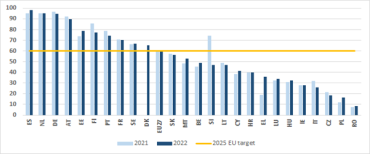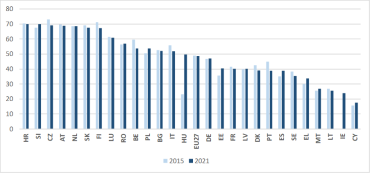The growth of work-based vocational education and training (VET) in the European Union already beats the targets set, albeit with considerable imbalances between Member States.
Post-2020 European VET policies seek to strengthen work-based learning as a key feature of initial VET (IVET) systems. Work-based learning can provide a bridge to the labour market by supporting the transition from education to work and developing relevant skills for the labour market.
As Cedefop data insights indicate, in 2022, in the European Union, an estimated 60.1% of recent VET graduates (20-34-year-olds with a vocational qualification, at ISCED levels 3 or 4, obtained in the last three years) had a period of work experience as part of their studies.
This figure already exceeds the target of 60% by 2025 set in the 2020 Council Recommendation on VET and the 2021 Council Resolution on the European Education Area.
However, there are significant geographical differences behind the EU average. Estimates of recent VET graduates having a period of work experience ranges from 8.4% in Romania to 98.4% in Spain.
Periods of work experience as part of VET also tend to be long and paid. In the EU overall, in 2022, 37.9% of recent VET graduates had a ‘long’ work experience, defined as seven months or more. Some 22.2% had a ‘short’ work experience lasting from one up to six months.
Furthermore, 39.9% of recent VET graduates reported that they were paid during their work experience and 20.2% that they were not.
Duration of, and payment whilst on, work experience also varies considerably across Member States. In Germany, Austria, the Netherlands and Denmark, a high proportion of recent VET graduates benefited from long and paid periods of work experience. In other countries short, paid and unpaid periods of work experience are more common.
For more information on work-based learning, see Cedefop’s data insights. For a comprehensive comparative statistical snapshot of EU and Member State progress towards their education and training and related targets for 2025/30, check out Cedefop’s Key indicators on VET and European VET policy dashboard.


